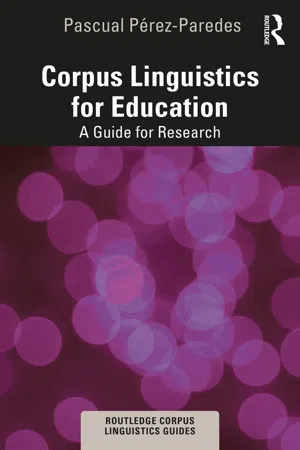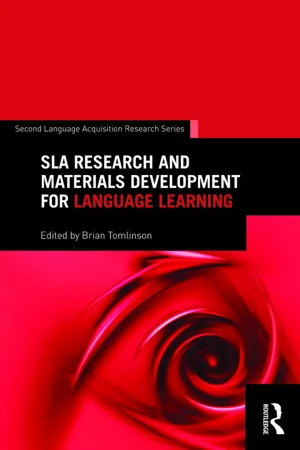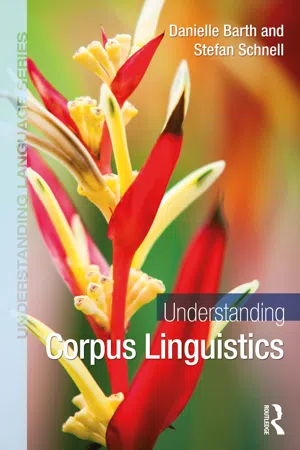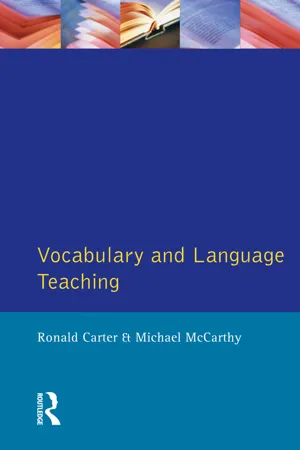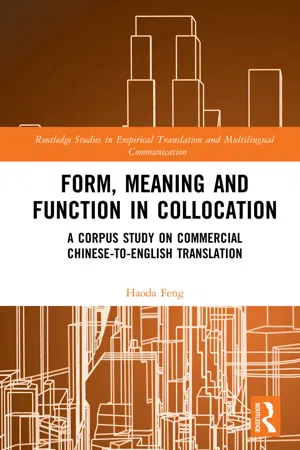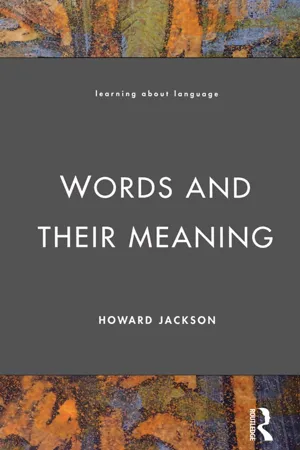Collocations
Collocations are combinations of words that frequently occur together in a language. They are important in understanding the natural use of language and can vary across different languages and dialects. Collocations can include verb-noun combinations, adjective-noun pairings, and other word combinations that are commonly used together in speech and writing.
8 Key excerpts on "Collocations"
- eBook - ePub
Corpus Linguistics for Education
A Guide for Research
- Pascual Pérez-Paredes(Author)
- 2020(Publication Date)
- Routledge(Publisher)
...This idea has important implications. In theme analysis and other methods, the semantics of the units analysed is rarely discussed or problematised, as if word meanings were obvious and their identification straightforward. Evert (2007: 4) defined collocation as follows: ‘a combination of two words that exhibit a tendency to occur near each other in natural language, i.e. to cooccur […] The term ‘word pair’ is used to refer to such combination of two words […]’. Sinclair (1991: 113) argued that the core meaning of a word is not a de-lexical one and that ‘frequent words have less of a clear and independent meaning’. Despite the limitations of an overemphasis on collocation (McEnery & Hardie, 2012), the analysis of individual word meaning in isolation may misrepresent how language is actually used. Collocates (Table 3.9) are the words that co-occur with node words in a corpus. Table 3.9 Essential terminology: collocate Essential terminology Collocate A collocate is a unit of analysis, typically a word, that has been found to co-occur with another unit in a corpus. In CL analysis, the implication is that a node and a collocate tend to co-select each other. BUT Collocates are identified statistically and, as different tests are used, so we should expect different results on the same dataset. Also, we need to frame our results exclusively within the corpus we are using. It would be misleading not to do so. There are at least two major ways to identify Collocations. One of those is to ask native speakers of a language to identify them. However, this methodology may be flawed as our intuitions about language are affected by so many variables, e.g. our own memory, retrieval routines, previous experience with different domains of the language, etc. One of the variables that affects our intuitions as native speakers is the frequency of occurrence of words in the language. Evert (2007) describes these Collocations as a phraseological, theoretical notion...
- eBook - ePub
Collocation
Applications and Implications
- G. Barnbrook, O. Mason, R. Krishnamurthy(Authors)
- 2013(Publication Date)
- Palgrave Macmillan(Publisher)
...This recognition, and the change in attitude that it led to among lexicographers engaged in the production of learners’ dictionaries, is part of the history of the development of the concept of collocation as a linguistic phenomenon, documented in Part I of this book. The role played by collocation both as part of the process of lexicography and as an element of the information provided in dictionaries has already been explored in the previous section. Collocation has formed a significant part of lexicography at least from Johnson’s Dictionary onwards, and plays a particularly important role within dictionaries produced for non-native learners of English. This was true to some extent even for the learners’ dictionaries produced in pre-corpus days, but since the COBUILD project it has become inescapable. The significance of collocation as part of the lexicographic analysis needed to produce corpus-based learners’ dictionaries, together with the need to provide information relating to collocation in order to explain word combination patterns, led inevitably to a change in focus in the teaching materials and methods used in language classes. This change in emphasis is often referred to explicitly in teaching materials as a necessary means of acquiring accurate and natural English. As an example, here is the explanation given in English Collocations in Use, a course book designed for self-study or use in classrooms and subtitled How Words Work Together for Fluent and Natural English : Why learn Collocations? You need to learn Collocations because they will help you to speak and write English in a more natural and accurate way. People will probably understand what you mean if you talk about ‘making your homework’ or say ‘My uncle is a very high man’ but your language will sound unnatural and might perhaps confuse...
- eBook - ePub
Language and the Lexicon
An Introduction
- David Singleton(Author)
- 2016(Publication Date)
- Routledge(Publisher)
...4 Lexical partnerships 4.1 Collocation: the togetherness factor We saw in Chapter 1 and again in Chapter 2 that a great deal of what was traditionally seen as coming under the heading of grammar is now considered to be essentially lexical in nature. The basic point we noted was that once a particular lexical choice has been made in a given sentence, this choice has a major impact on the determination of what else may or may not occur in the sentence in question. In addition to this strongly determinant aspect of lexical choice there is also an effect in respect of word selection which is rather more probabilistic in nature. This latter effect has to do with the fact that – for a variety of reasons – particular words are frequently to be found in the company of certain other words. In such cases the selection of one or more of the words concerned in a given context is quite likely – or even very likely – to be accompanied by the selection of another word or other words from its habitual entourage. For instance, if a radio or television presenter uses the word breaking, we are anything but surprised if the word news follows. Similarly with: at this moment in time law and order the Middle East peace process As has already been indicated in earlier chapters, this phenomenon of words ‘keeping company’ together is referred to as collocation. Collocation comes from two Latin words, the word cum (‘with’) and the word locus (‘place’). Words which form Collocations are repeatedly ‘placed with’ each other; that is to say, they often co-occur within a short distance of each other in speech and in written texts...
- Brian Tomlinson, Brian Tomlinson(Authors)
- 2016(Publication Date)
- Routledge(Publisher)
...9 An Evaluation of Textbook Exercises on Collocations Frank Boers and Brian Strong DOI: 10.4324/9781315749082-9 Introduction The past two decades have seen a proliferation of publications about lexical phrases such as idioms (e.g., pull strings ; sit on the fence; below the belt) and Collocations (e.g., make an effort ; pretty girl ; wide awake). This recent proliferation has been particularly noticeable regarding the latter type of lexical phrase – Collocations, i.e., combinations of words whose co-occurrence is so common that substituting one of the words by a near-synonym s ounds wrong (e.g., ? do an effort) or at least odd (e.g., ? a pretty man). The growing interest in the phraseological dimension of language has undoubtedly been stimulated by advances in two research disciplines. One is the discipline of corpus linguistics, which has revealed that lexical phrases abound in natural discourse (e.g., Sinclair, 1991). The other is psycholinguistics, where knowledge of formulaic expressions has been shown to be vital for fluent language processing (e.g., Wray, 2002). Given the importance of multi-word lexis in language and language processing, it stands to reason that second language (L2) or foreign language (FL) learners can benefit considerably from developing a sizeable repertoire of lexical phrases. Indeed, several studies have shown that a growing command of phraseology is part and parcel of becoming proficient in an L2 or FL (e.g., Boers, Eyckmans, Kappel, Stengers, & Demecheleer, 2006) and that knowledge of lexical phrases benefits both receptive and productive fluency (e.g., Ellis, Simpson-Vlach, & Maynard, 2008 ; Wood, 2010)...
- eBook - ePub
- Danielle Barth, Stefan Schnell(Authors)
- 2021(Publication Date)
- Routledge(Publisher)
...Moreover, the clitic forms a phonological word with whatever element precedes it, so that an account of their occurrence needs to refer not only to syntactic but also to morphological and phonological structure. How structural contexts are defined depends not only on the type of linguistic unit under discussion but also on the linguistic (and often theoretical) conceptualisations a corpus linguist will bring to the playing field: for instance, some linguists think of syntactic structures in terms of dependencies between words whereas others rely primarily on aspects of constituency, and many (if not most today) combine these two notions (see Section 7.2.4 on treebanks). Of particular prominence in corpus linguistics is the contexts of words, and related to this the corpus linguistic concepts of Collocations. The term collocation refers to the co-occurrence of multiple lexemes, often two lexemes, called a bigram and a co-occurrence of three lexemes is called a trigram. We can search for a specific lexeme in a corpus and determine its collocates, that is, a list of lexemes that co-occurs with it. A collocate refers to the “next door neighbour” of a lexeme, which may be on either side of the lexeme. The lexeme of interest will often be referred to as w, the lexeme before a lexeme of interest will often be referred to as w −1 and the lexeme after it will often be referred to as w+ 1. You may also see L1 (one lexeme to the left of a lexeme of interest) or R1 (one lexeme to the right of a lexeme of interest). Exercise 2.4 Token labels Your lexeme of interest is world. What is the w− 1 and w +1 in the sentence FIFA Women’s World Cup 2019 winner was the USA ? How would you refer to FIFA using this kind of label? How would you refer to winner ? List all the bigram tokens in the sentence above in alphabetical order...
- eBook - ePub
- Ronald Carter, Michael Mccarthy(Authors)
- 2014(Publication Date)
- Routledge(Publisher)
...288) Collocation is left undivided, as a general relation of likely cooccurrence. This scheme makes for a convenient analytic tool for texts, especially written texts. Although similar patterns can be seen in spoken language data, McCarthy has argued in Chapter 4 of this book that the model needs considerable refinement to make it able to handle the complexities of conversation. From an applied point of view, it should be possible to examine learners’ written texts to see how they do or do not conform to native-speaker texts in the use of lexical cohesive ties. Certainly, one way of making notions such as synonymy and antonymy practically useful to learners is to show them how such relations occur over sentence boundaries in texts. In reading comprehension it is often important that the reader be aware of synonymy and antonymy between words which might occur sentences apart, and Chapman (1983, p. 46) argues that teachers of reading need to know more about the ability of skilled readers to perceive such cohesive links in texts. Collocation, in the original Halliday and Hasan scheme, was left undivided. It thus became a sort of ‘ragbag’ category where associations (sometimes quite weak or difficult to define) between lexical items in a text could be recorded. Even texts with low levels of lexical reiteration in Halliday and Hasan’s sense still seem to have multitudinous relations between their lexical items which carry across clauses, sentences and sometimes whole stretches of text. In the aviation text (1), we can see associations between air/noises/aviation, zenith/fashionable/lapsed/broke out again/intensity, war/armistice, and so on, associations difficult to define or label...
- eBook - ePub
Form, Meaning and Function in Collocation
A Corpus Study on Commercial Chinese-to-English Translation
- Haoda Feng(Author)
- 2020(Publication Date)
- Routledge(Publisher)
...In this respect, the use of accurate Collocations plays a very significant part in identifying non-native speakers’ second language competence (see e.g. Wray, 2002), which implies that collocation can be a valid measure to make a distinction between translational language and native-speaker language. Previous studies (e.g. Baker, 2004; Xiao, 2010) have demonstrated some theoretical frameworks to distinguish translational language from native-speaker language which, to a certain extent, contribute to both the studies of translational language and the studies of collocation. Particularly, along with the advent of large-scale corpora, researchers are provided with more opportunities to explore collocation patterns in translational language by examining authentic language materials. The findings of these studies appear to reflect a similar generality: L2 learners deviate from native speakers in the way they learn and use Collocations. In other words, this type of research aims to uncover how receptive linguistic skills can be turned into productive linguistic skills, resulting in the use of native-like collocation in translations. This is also the rationale underpinning the present study. Nevertheless, the role of collocation has not been given enough attention or discussed systematically in TS. To be more specific, much of the previous research on collocation merely focuses on L2 acquisition, rather than comparing translational language and native-speaker language to identify the role of collocation in translation. In addition, no studies have, up to date, shown that the inappropriate use of Collocations may cause some translation universal features in translational language, or have discussed the relationship between collocation and the indicators of these translation universal features...
- eBook - ePub
- Howard Jackson(Author)
- 2014(Publication Date)
- Routledge(Publisher)
...This is really a rather unsatisfactory way of obtaining data on collocational patterning. Indeed we may argue that, in spite of its widespread practice by linguists, it is an unsatisfactory way of arriving at any linguistic data. It is preferable to observe language in use, in the everyday spoken and written communication of language users, as the basis of the study of linguistic phenomena. In order to proceed in this manner, linguists usually collect a corpus of spoken and written texts which will be as representative of the range of language varieties as is appropriate to the linguistic investigation being undertaken. The first step in discovering the collocational patterns of English is to provide ourselves with a corpus consisting of a representative sample of texts. We then need to decide which lexemes we are intending to investigate in order to discover the other lexemes that regularly cooccur with it. The lexeme under investigation is called the node. We have to decide how many words either side of the node we are going to look at in order to find regularly cooccurring lexemes. This is called the span. A span of five words either side of the node is usually sufficient to throw up all the significant Collocations of that node. The next part of the task is basically a counting one. We need to go through our corpus and find all the examples of the node (lexeme) that we are interested in. Then we count how many times each of the five words to the left and each of the five words to the right of each occurrence of the node occurs in the corpus as a whole. We can then construct a table of lexemes that occur in the company of the lexemes that we are interested in (its collocates) and how often they occur. Clearly, the more frequently they occur, and if they occur with a frequency greater than chance, then we will have identified a significant collocational pattern...
